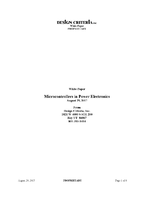Machine-Vision Camera mimics human learning.
Press Release Summary:

ZiCAM Zi-640 self-learning, machine-vision system is embedded into 60 fps, 640 x 480 pixel digital video camera. Neural network-based Zero Instruction Set Computer eliminates need for programming to execute image-understanding algorithms. Self-contained unit integrates 8 actuator drivers, communicates via Ethernet, and uses ZiCAM Teacher software to guide human tutor through learning process. It is suitable for inspection, recognition, presence/absence, and positioning applications.
Original Press Release:
Pulnix Introduces Next Generation of Smart Cameras
The New Zi-640 Allows Machine Vision to Perform Tasks That Once Required Human Supervision.
March 21, 2003. PULNiX today announced the ZiCAM Zi-640, a self-learning machine vision system embedded into a high-performance digital video camera. The neural network based Zero Instruction Set Computer-ZISC-integrated into this smart camera eliminates the need for programming to execute image-understanding algorithms. Instead, the Zi-640 learns what is required for the application, and once taught, operates as a stand-alone machine vision system.
The Zi-640 is fast: it can solve complex problems in "real time" (30 frames per second). It is capable: its 312 neuron ZISC can solve problems that conventional computers may require 100's of MIPS to solve. It can easily be networked: it communicates via Ethernet. It is also self-contained: it integrates eight actuator drivers for direct response image-understanding results.
The Zi-640's ability to mimic human learning makes it particularly well suited for inspection, recognition, presence/absence and positioning applications. Because the Zi-640 learns using a neural network, it is very good at solving the sorts of machine vision problems that are usually done by human operators. It is suited for solving problems in such diverse fields as the pharmaceutical industry, manufacturing, security, and commercial fishing. The Zi-640 can reliably determine if a pill was really dropped into a medicine vial, if the cotton was really placed in the top of the pill bottle, or if the label on the bottle was applied, and verify that it was the correct label, applied correctly. The Zi-640 can determine with an extremely high degree of accuracy if a fish on a conveyor belt is a Mackerel, and if so, whether its head, tail and dorsal fin are positioned correctly. It can keep watch on a manufacturing line to alert when the die on a punch press is wearing out. It can recognize an insertion location for an IC, and it can tell if someone is standing in front of elevator doors.
Central to the Zi-640 is its user-friendly software called "ZiCAM Teacher." ZiCAM Teacher guides a human tutor, often an expert in the relevant subject matter, through the
learning process, thus expediting the time required to reach a fully taught ZiCAM. Teaching involves capturing several good images, annotating those images, processing those images in the ZISC, and then testing the state of learning using unknown examples. The Zi-640 learns by doing. Since this process is conducted via the Ethernet network, a ZiCAM can installed anywhere in the world that has Internet access, even if the tutor is thousands of miles away.
"For the first time, a machine vision system can be easily, cheaply and quickly upgraded to accommodate local problems," says Toshi Hori, President of PULNiX and holder of ZiCAM patents. "By eliminating programming costs and guaranteeing successful performance no matter what the local conditions might be, ZiCAM dramatically reduces the real cost of machine vision usage."
The Zi-640 begins with a 60fps 640x480 pixel digital camera. The camera's high speed makes it suitable for applications moving too fast for human detection. The Zi-640 comes in both monochrome and color. This extends its capabilities to include not only human-like understanding, but also human-like detection. To make installation and local verification quicker and easier, the Zi-640 has a direct monitor drive that provides real-time video without needing any other support electronics. The integral 340 MB microdrive allows for the storage of raw video images, including those captured of "no-go" conditions. Finally, the Zi-640 provides eight separate actuator driver outputs. This assures proper system response for a variety of image-processing results.
The Ethernet networking capability not only allows the system to be optimized for local conditions, it also makes it possible to use the same Zi-640 for a variety of different applications. Once taught, the ZISC parameters can be stored off-line and reinstalled when needed. This means, for example, that if labels are being inspected, and the line changes to a different product with a different label, the Zi-640 can be inspecting the new
labels in the few seconds it takes to download the proper parameters.
The Zi-640 is small and rugged. It measures 73 by 73 by 67 mm, and will withstand 70g of shock and 7 Grams of random vibration from 10-2000 Hz. It operates in temperatures ranging from -10°C to 45°C. It uses a single 12V DC power supply and standard C-
Mount optics. It can be externally triggered to assure that the image captured always contains the objects of interest.
While the Zi-640 can be taught to operate in a wide variety of ambient lighting conditions, an optional lens-mounted solid-state strobe is available.
The Zi-640 is available now. Single-quantity price is $3995. Volume pricing is available upon request.
For more information, please contact:
Don W. Lake
PULNiX America
1330 Orleans Drive
Sunnyvale, CA 94089
(800) 445-5444
dlake@pulnix.com
PULNiX America, Inc. is a manufacturer of high quality, industrial-grade cameras for the machine vision, security, manufacturing, military, aerospace, medical and scientific markets. PULNiX includes an ITS (intelligent transportation systems) division that develops and implements ITS solutions for government and private organizations. We are a member of the
Takenaka Group Center and are the major North American supplier for Takenaka Electronics' line of photoelectric and laser products.
PULNiX provides the broadest camera offering of any industrial matrix camera manufacturer in the world. PULNiX's product line features both CCD and CMOS technologies, spatial resolution
from VGA to multi megapixel, progressive scan and interlaced format, and sensitivity to light levels as low as .00001 lux. Our camera offerings include both monochrome and color, capture
rates from real-time to over 1000fps, and a wide variety of physical interfaces including Camera Link(TM). We also offer many other crucial, cutting-edge capabilities.
History
The Takenaka family of companies was founded in 1959 in Kyoto, Japan to manufacture and sell infrared photoelectric controls. Takenaka Engineering Co., Ltd. was created in 1972 to manufacture infrared intrusion detectors for the security market. These innovative security products quickly captured 65% of the Japanese market but remained relatively unknown outside
of Japan. PULNiX America, Inc. was founded in 1982 in Mountain View, California as Takenaka Engineering's marketing arm to the western world.
Within a year, PULNiX established a reputation for excellence in both products and technical support. The largest security products distributors and installing companies in the United States were carrying the PULNiX product line. In 1983, PULNiX established a sales office in the United Kingdom to introduce its products to European markets.
In late 1983, PULNiX first offered miniature solid-state cameras based on new Charge Coupled Device (CCD) technology. The TM-34K CCD camera generated a very clear, geometrically precise video image. Using the broad range of special customer camera requirements as design mandates, PULNiX developed functional options that made these cameras readily adaptable to many applications for both the industrial and surveillance user. A new generation of exclusive CCD cameras was born.
In 1984, PULNiX added infrared photoelectric controls to its newly established industrial distributor network, contributing to the diversity of the PULNiX industrial product line. It wais also in 1984 that PULNiX moved its facilities from Mountain View to nearby Sunnyvale, where the company still operates.
As a part of the ongoing effort to better serve our customers worldwide, PUTLNiX opened an office near Frankfort, Germany in 1985. In 1987, PULNiX expanded its Sunnyvale operation to
20,000 square feet to allow full-scale domestic manufacturing of its video products. By 1983, primary manufacturing of PULNiX's very popular video products was underway. An Australian sales office opened in 1989 to further support our global sales effort.
Present
Today, PULNiX manufactures virtually all its video products at its CA facilities. Most of its infrared photoelectric controls and security products are made in Japan. Five sales offices service our customers worldwide.
PULNiX is an ISO-9001 certified manufacturer and customer-driven organization well known for high quality, technical innovation, and miniaturization. PULNiX follows a policy of Total Quality
Management (TQM) that builds quality in at every step through continuous process improvement. "Quality" at PULNiX means meeting and exceeding customer needs and expectations consistently and efficiently.




